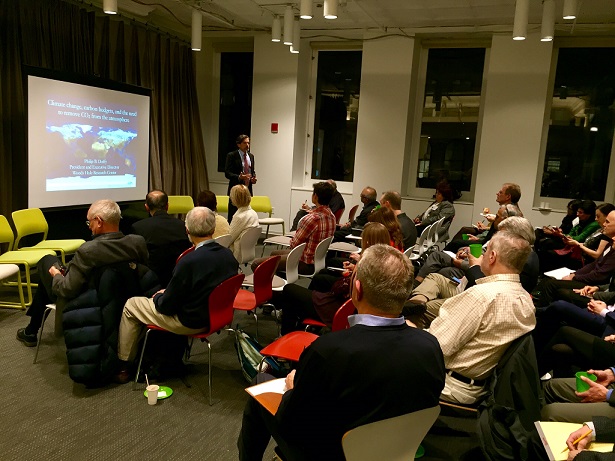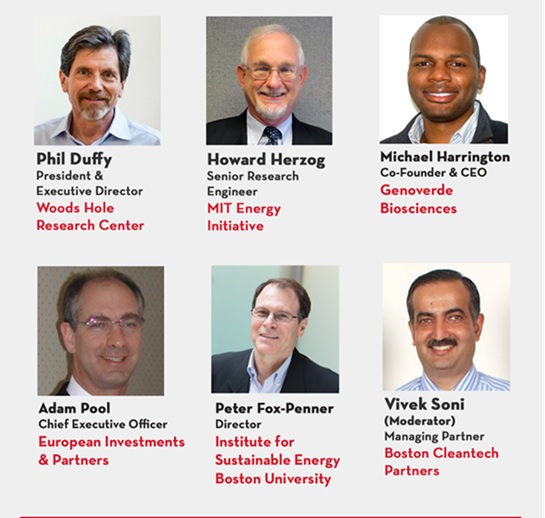Contribute
| Moving The Needle On Climate Change |
Vivek Soni
12/07/2016
TiE Boston organized a Deep Dive event on December 5, 2016 evening on the topic of “Moving the Needle on Climate Changeâ€. The event was sponsored and hosted by the Massachusetts Clean Energy Center (MassCEC) at their office in Boston.
The primary objective for the event was to provide a comprehensive overview about the challenges related to carbon dioxide (CO2) accumulation in the atmosphere and the consequences of letting the atmospheric concentration of CO2 get out of hand. The event was organized and moderated by Vivek Soni, Managing Partner at Boston Cleantech. Phil Duffy, the President of the Woods Hole Research Center, made the case for actively managing the CO2 concentration in the air rather than passively letting it build up. The International Center for Climate Governance has recognized the Woods Hole Research Center, based in Falmouth MA, as the top Climate Change Think Tank in the World for three years in a row from 2013-2015.
We know that the 2015 United Nations Climate Change Conference, COP 21 ratified a non-binding agreement for “holding the increase in the global average temperature to well below 2°C above pre-industrial levels and to pursue efforts to limit the temperature increase to 1.5°C above pre-industrial levels, recognizing that this would significantly reduce the risks and impacts of climate changeâ€.
An important message from Phil is that even in the context of the broad agreement of the limit 2°C there is a major concern that we could be on an irreversible path of environmental damage in 7-10 years. The risk arises from the long lifetime of CO2 in the atmosphere. The current level has reached 400 ppm which corresponds to two thirds of the limit required to get to the amount of CO2 required for 2°C temperature rise. Once the CO2 is in the atmosphere, even if no more CO2 was emitted going forward, given the current systems, the temperature rise would not change for hundreds of years. All future emissions of CO2 push the global average temperature rise to a much higher level.
The big unaccounted risk is from the thawing of the permafrost. This is a self-reinforcing process with potentially catastrophic consequences. Another self-reinforcing risk is the melting (mass loss) of the Greenland ice sheet. Because of the expected emissions from thawing permafrost during the period from 2015 to 2100, amount of emissions that can be tolerated at the current rate correspond to just 7-10 years before we hit the irreversible limit of a 2°C temperature rise.
To avoid the consequences of permafrost thawing and melting of the Greenland ice sheet, Phil estimates we need to have a global capacity to remove 100-300 GtC (associated with 2°C temperature rise). [Note: 1 gigatonne of carbon (GtC) is 109 tonnes C = 3.67 Gt carbon dioxide]. The annual emissions currently are 10 GtC. According to the Woods Hole Research Center, 130-160 GtC can be biologically removed from the atmosphere can be captured by reforestation, restoring carbon to agricultural soils and restoring coastal wetlands. Doing this is a major challenge in a world of growing populations and rising sea levels. Therefore, there is a need to have a capacity to remove an additional 100 GtC by what is called carbon capture and storage or sequestration (CCS).
As defined by the Intergovernmental Panel on Climate Change (IPCC), Carbon dioxide capture and storage (CCS) is a process consisting of separation of CO2 from industrial and energy-related sources, transport to a storage location, and long-term isolation from the atmosphere.
Howard Herzog has been the leading researcher at MIT working on CCS. His message was that the technologies for carbon capture and sequestration have been demonstrated at commercial scale but are not commercially viable today for wide scale deployment. It is almost always cheaper to emit CO2 to the atmosphere than sequester. Therefore, opportunities are limited to niche areas until carbon policies are put in place. Howard described a wide range of technologies that have been evaluated and demonstrated. He also described various projects. The Global CCS Institute (GCCSI) lists 22 projects that are operating, have operated, or are under construction. 21 of the 22 demonstration projects have occurred in a region with a significant oil & gas industry. Three projects are in the power sector. Howard said that the Carbon Price needed to incentivize CCS with geologic storage is $50-100/tCO2. This would result in an increase in cost of electricity from 40-90%. Additional incentives required to overcome first-of-a-kind costs. The final message from Howard was “Carbon Dioxide Capture and Storage (CCS) is technically viable today and has significant scope for improvement. Policy to put the world on a “stabilization†pathway is required to make CCS economically viableâ€.
Michael Harrington, CEO of Genoverde Biosciences described how his startup company, affiliated with UMASS Amherst, is bioengineering tree seedlings with increased CO2 capture qualities resulting in higher wood density trees. This tied in with the message from Phil about bioengineering trees to enhance CO2 capture by trees.
Many people believe that European organizations and corporations are better aligned than their counter parts in the US around action to enact initiatives that can reduce the impact of climate change. Adam Pool, from the Clean Energy Venture Group, gave an important clarification that while the European Commission policies are more in favor of collective action to reduce climate change, policies in member countries are centered around many of their favorite industries and resources. Such a disconnect between member states and the European Commission does not provide an easy path to significant collective action in Europe, irrespective of what is done by the US, China etc.
Peter Fox Penner helped summarize the themes from the various speakers. He is the Director of the Institute for Sustainability at Boston University. Peter agreed with the need to pay appropriate attention to CCS while addressing all other pathways to reduce CO2 emissions. His final message was captured in two words – Hope and Responsibility. Hope from the progress that can come from technology advances and the need for responsibility so that we can own the consequences of our actions. Now is not the time to ignore these major environmental challenges.
The audience participated in a very rich discussion offering several ways to reduce carbon emissions and policy matters. Many countries, communities and corporations have been focused on reducing their CO2 emissions from a 1990 reference point. The important takeaway from this event is that managing (reducing) emissions going forward is not a sufficient solution to drastic environmental impacts. One of the speakers said if there was ever a need for a Manhattan type of project for a cleantech solution it is for commercializing carbon capture and sequestration.
The most important questions to reflect on were suggested by Phil Duffy: “How much climate change is OK? Where are the tipping points? What are the impacts of different amounts of warming?â€
You may also access this article through our web-site http://www.lokvani.com/

